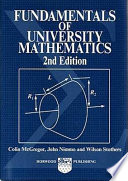 | Hermann Grassmann - Ausdehnugslehre - 1862 - 412 pages
...ci ftbc = (ab) c usw 8. Erklärung. Für extensive Grossen a, b, c gelten die Fundamentalformeln : 1) a + b = b + a, 2) a + (b + c) = a + b + c, 3) a + b — b = a, 4) a — b + b = a. Beweis. Es sei a = Zae, b = 1) a + b = ^öe + jL/Se — JjL(a... | |
 | Hermann Grassmann - Ausdehnungslehre - 1894 - 986 pages
...Anfang eintreten, also und so weiter. 8. Für extensive Grossen a, b, c gelten die Fundamentalformeln: 1) a + b = b + a, 2) a + (b + c) = a + b + c, 3) a -fb — b = a, 4) a — b -j- 6 ^ a. Beweis. Es sei a = Zae, b = Zße, c = Zye, so ist 1) Z ße... | |
 | Henry Burchard Fine - Algebra - 1904 - 616 pages
...natural numbers, we first defined addition as a process — counting forward — and then showed thai; the results of this process have two properties which...the numbers added, namely : 1. a + b = b + a. 2. a + (l> + c) = (a + ft) + c. Similarly we proved that products possess the three general properties :... | |
 | Česká společnost náuk, Prague. Třída matematicko-přírodovědecká - Botany - 1924 - 494 pages
...soll (a, b) = (a1, b') sein. Für diese Operation gilt das kommutative und assoziative Gesetz, also 1. (a, b) — (b, a), 2. ((a, b), c) = (a, (b, c)) . Weiter gilt 3. (a, b) k=(ak, bk), _ 4. (1, 1) = 1. Aus 3 und 4 folgt unmittelbar (a, a) — a. Elemente,... | |
 | I. M. Gelfand - Mathematics - 1989 - 212 pages
...of linear transformations have some of the properties usually associated with these operations. Thus 1. A + B = B + A; 2. (A + B) + C = A -\- (B + C); 3. A(BC) = (AB)C; ! | (A + B)C = AC + BC, ' ( C(A + B) = CA + CB. We could easily prove these equalities... | |
 | Colin M. McGregor, Colin McGregor, Jonathan J. C. Nimmo, John Nimmo, Wilson Stothers - Mathematics - 1994 - 564 pages
...subtraction in terms of addition, so А— В means A+(— B). Theorem 11.2.3 IfA,B,CG Mmx„(F), then (1) A + B = B + A, (2) A + (B + C) = (A + B) + C, (3) A + Omxn = A, (4) A + (-A) = Omxn. Proof We prove (2) and (4), The others are left as an exercise... | |
 | Hermann Günther Grassmann - Mathematics - 440 pages
...assembly." Addition and subtraction are thus defined, since first of all the four fundamental formulas 1) a + b = b + a, 2) a + (b + c) = (a + b) + c, 3) a + bb = a, 4) ab + b = a hold; and in addition the magnitudes resulting from the conjunction must... | |
 | Larry C. Andrews, Ronald L. Phillips - Mathematical analysis - 2003 - 822 pages
...general, vector addition has the following properties: Figure 4.2 Parallelogram law for vector addition. 1. a + b = b + a 2. a + (b + c) = (a + b) + c 3. K(a + b) = Ka + Kb 4. a + 0 = a 5.a + (-a) = 0 6. a + a = 2a (4) Note that Properties 3 and 6 listed... | |
 | Henry Burchard Fine - Mathematics - 18?? - 648 pages
...— definitions of new operations. Thus, it would be absurd to attempt to prove that 2(— 3)=— 2-3 with nothing to start from except the definition of...added, namely : 1. a + b = b + a. 2. a + (b + c) = (a + ¿») + c. Similarly we proved that products possess the three general properties : 3. ab = ba. 4.... | |
 | Pierre Dugac - Philosophy - 1976 - 344 pages
...à A, alors a + b et a - b appartiennent à A, ayant les propriétés suivantes : (1') a+b = b+a, . (1") a - b = b - a, (2') (a + b) + c = a + (b + c), (2") (a - b) - c = a - (b - c), (3') a + (a - b) = a, (3") a - (a + b) = a. Parmi les exemples de groupe... | |
| |